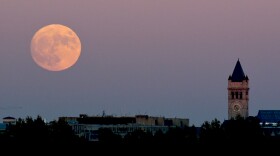-
A black moon is a type of new moon, when the moon is nearly between Earth and the sun.
-
A bright moon will make it hard to see the Perseid meteor shower in mid-August, but one night this week offers a decent chance of seeing some shooting stars.
-
The next supermoon — which appears larger and brighter than a regular full moon due to its proximity to Earth — will not be visible for nearly a year.
-
The celestial event will coincide with the summer solstice for the first time since 1985.
-
Millions of Texans and many, many visitors are gearing up for a once-in-a-lifetime experience. Here are eight things you should know in preparation for this celestial event.
-
NASA successfully crashed a spacecraft into an asteroid in a test of planetary defense. Now it will determine whether the mission was able to alter the asteroid's course.
-
June's full moon gets its nickname from the strawberry harvesting season in the Northeastern U.S. It also happens to be at its closest distance to Earth in its orbit, which makes it a supermoon.
-
Caitlin Casey, an astronomer with the University of Texas and the Big Bend region’s McDonald Observatory, will co-lead the largest research project in the first year of the powerful new telescope’s operation.
-
The comet was discovered less than a year ago near the orbit of Jupiter. Now, observers in North America can see it in the northeastern sky around sunrise.
-
Wipe the dust off your binoculars and extract the family telescope from the back of the closet: Saturn is about to put on its best and brightest show of the year — an act Jupiter will soon follow.
-
Its name has ties to strawberry picking season, and when the strawberry moon appears above the horizon, the marginal supermoon will look large and gold.
-
Early risers across the Northern Hemisphere will be able to see an eclipse Thursday morning when the moon passes between the Earth and the sun.
Play Live Radio
Next Up:
0:00
0:00
Available On Air Stations












